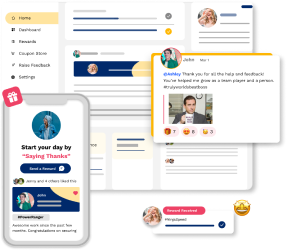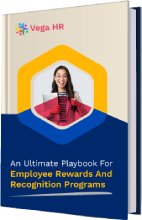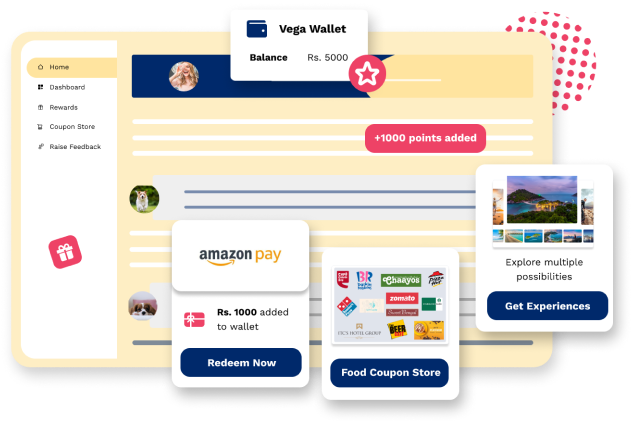Introduction
In today's fast-paced and highly competitive business world, organizations are constantly looking for ways to attract and retain top talent. One of the most effective ways to do this is through employee rewards and recognition programs. Such programs are designed to recognize and appreciate employees' hard work, dedication, and contributions to the organization. However, not all employee recognition programs are created equal. An effective program must align with the company's culture, values, and goals to have a positive impact on employee engagement, productivity, and retention.
By investing in employee rewards and recognition programs, organizations can not only boost employee morale but also improve productivity, engagement, and retention. Such programs also help create a positive work environment where employees feel valued, respected, and appreciated for their contributions.
This blog will explore the latest trends, best practices, and benefits of employee rewards and recognition. It will also provide insights into how organizations can implement an effective program that aligns with their culture, values, and goals. It will also cover everything from the differences between rewards and recognition to the importance of regular feedback and communication.
Why Rewards and Recognition For Employee Engagement?
Before we understand the nuances of building a rewards program, let us first try to understand how an R&R program can benefit an organization.
Increased motivation and engagement: Employees can be encouraged to work harder, be more productive, and have higher job satisfaction by receiving rewards and recognition. Employees are more likely to be engaged in their work and go above and beyond what is asked of them when they feel valued and appreciated.
Retention of talent: By fostering a sense of value and appreciation among employees, employee awards and recognition can aid in retaining top talent. Employee loyalty and retention are higher when they believe their contributions are valued and appreciated by the organization.
Improved performance: Employee performance can be improved by setting clear goals and objectives for them and recognizing their accomplishments when they reach them. This may result in a culture of ongoing development and a focus on reaching the goals set.
Positive company culture: By encouraging a sense of community, teamwork, and collaboration, rewards and recognition can contribute to developing a positive workplace culture. Employees are more likely to support and encourage their coworkers, creating a more positive work atmosphere, when they believe that their efforts are acknowledged and valued.
Increased customer satisfaction: Employee awards and recognition can contribute to increased customer satisfaction because employees who feel valued and appreciated are more likely to give superior customer service and go above and beyond to meet the needs of their customers.
Numbers play a very important role in telling a story. Here are some intriguing statistics that gives you a deep understanding of the impact of an employee rewards and recognition program.
Employee Rewards and Recognition – A Story of Numbers
- Organizations with a recognition program are more likely to have higher employee engagement levels (68% versus 53% for those without a program). (Source: Society for Human Resource Management (SHRM))
- 88% of organizations have a recognition program. (Source: WorldatWork)
- 44% of employees stated that they would like to receive recognition every week or more. (Source: Achievers)
- 47% of employees cited recognition and rewards as a top contributor to their job satisfaction. (Source: Society for Human Resource Management (SHRM))
- Companies with recognition programs that are highly effective at improving employee engagement have a 31% lower voluntary turnover rate. (Source: Deloitte)
- Employees who receive regular recognition and praise are more engaged, productive, and likely to stay with their company long-term. (Source: Gallup)
- 80% of employees feel more motivated to work when they receive recognition. (Source: Achievers)
Keep your team engaged and motivated
- Send rewards and shortcuts
- Built a sense of purpose
- Hybrid-work friendly rewards
- Showcase your core values
Contact Us
Difference between Rewards and Recognition
While employee rewards and recognition are often used interchangeably, there is a difference between the two and each word has a distinct meaning and subsequent role. So how different are they?
Employee rewards are the material or monetary incentives provided to staff members in exchange for their performance or accomplishments. Bonuses, gift cards, paid time off, and other types of compensation may be among them. Incentives are frequently used to inspire workers to reach predetermined objectives or to honor excellent achievement.
On the other side, employee recognition is the acknowledgment of a worker's contributions or accomplishments at work. Verbal praise, achievement certificates, public acclaim, and other non-monetary incentives are just a few examples of the many ways that people can be recognized. Recognizing good behavior, fostering a great workplace culture, and boosting employee engagement and motivation are all frequently achieved through recognition.
While both employee rewards and recognition are important in the workplace, they serve different purposes. Rewards are often used to incentivize specific behaviors or reward exceptional performance, while recognition is focused on acknowledging employees' contributions and fostering a positive work environment. Ultimately, a combination of rewards and recognition can be effective in motivating and engaging employees and improving performance in the workplace.
Challenges for your R&R program
Programs for employee rewards and recognition can improve an organization's financial performance, but setting up a successful program is not always simple. While creating and implementing a recognition program, organizations may run across a variety of challenges -
- Creating a program that aligns with the organization's culture, beliefs, and objectives is a major challenge. A program that neglects these aspects may not be successful and can harm staff morale
- Organisations must study the factors and personalize the program to employees' requirements and preferences
- The program should promote fairness, and openness and offer equal opportunity to all employees
- All employees should be informed about the program's criteria and benefits
- Encourage employee participation for the program's success
- Employees may have doubts about the program's effectiveness, so the benefits and design should take their input into account
- To develop an efficient program, organizations should comprehend its objectives, secure the required funding, develop a fair and transparent program, encourage employee participation, and measure its effectiveness.
Building a Successful R&R Program with Vega HR
A platform for employee incentives and recognition that you build with Vega HR includes a variety of components that can improve your workplace environment. Vega HR offers a variety of features, from strategy development to implementation, including an internal social network, a feedback system for better implementation, and improved capabilities to handle issues like employee retention and building a hybrid workspace that unites all of your employees.
As a result, you can make sure that employee efforts are in line with corporate goals and objectives by integrating incentives and recognition programs into their performance management systems. Additionally, Vega HR will assist you in setting up performance indicators to monitor the effectiveness of various organizational functions and in developing a feedback mechanism for open communication.
So, all in all, Vega HR has time and again proved to be your perfect companion to enhance your company’s work culture and curate the most perfect employee experience. Visit our site to know more!
Frequently asked questions
About Vega HR
Vega-HR is a powerful tool in the talent war, offering employee rewards, recognition, and pulse recognition. With an engaging platform, it fosters a world-class work culture, providing P2P recognition, social feedback, on-spot recognition, and monetizable incentive solutions with 3000+ coupons in various categories.
Create a Culture People Want to Stick to
- Send rewards
- Give shoutouts
- Build a community
- Gift experiences
Get a demo
 Written by Varshith Mittapalli 20 March 2023 | 4 min read
Written by Varshith Mittapalli 20 March 2023 | 4 min read






